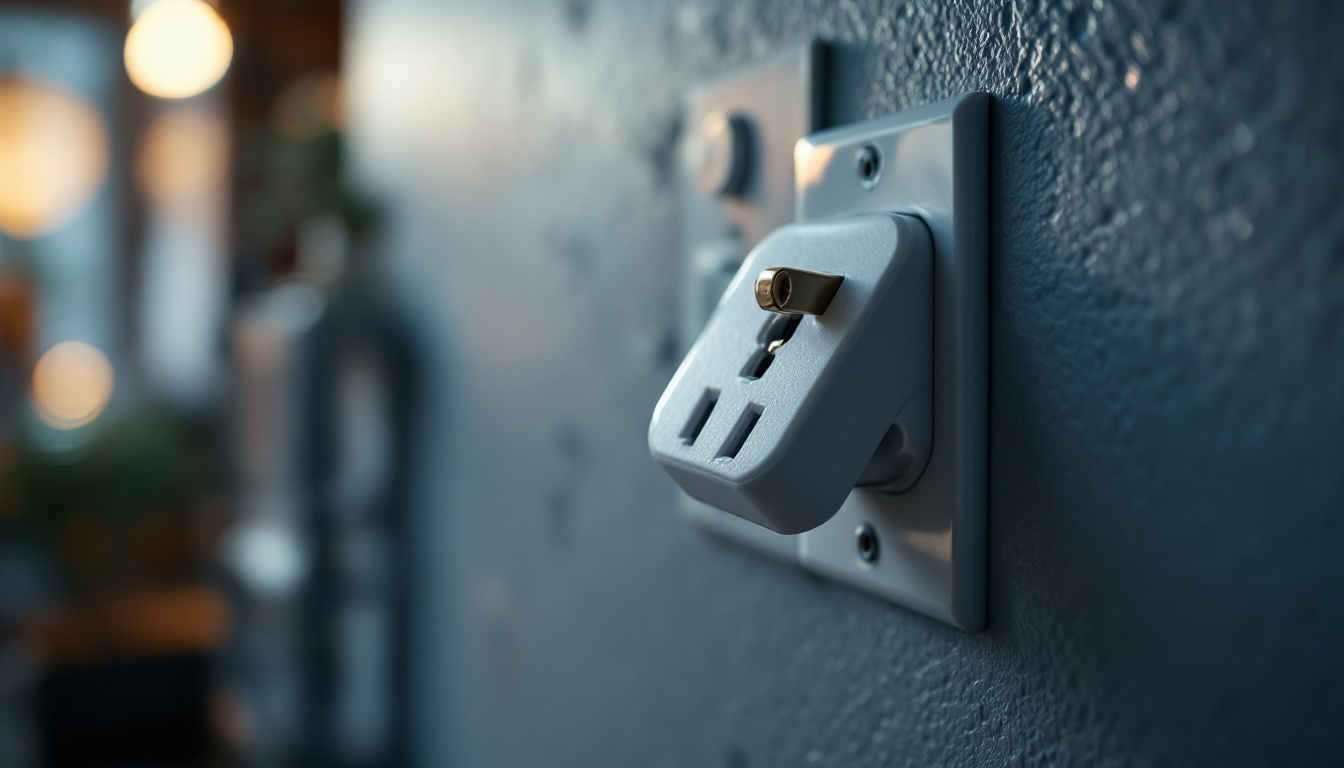
In the world of electrical installations, particularly for lighting contractors, the importance of secure connections cannot be overstated. A loose plug can lead to intermittent power supply, which not only affects performance but can also pose safety hazards. Understanding how to lock a plug in an outlet is essential for ensuring reliable and safe lighting installations.
This article delves into the science behind plug locking mechanisms, discussing their design, benefits, and practical applications in the field. By grasping these concepts, lighting contractors can enhance their installations and provide better service to their clients.
Plug locking mechanisms come in various forms, each designed to address specific challenges faced in electrical installations. For instance, twist-lock plugs are popular in commercial settings where equipment is frequently connected and disconnected. These plugs feature a rotating collar that secures the connection, preventing accidental disconnection due to movement or vibration. This is particularly beneficial in environments like theaters or event spaces where lighting equipment is often repositioned. Moreover, the use of locking mechanisms can significantly reduce wear and tear on both the plug and outlet, extending the lifespan of the equipment and minimizing maintenance costs.
In addition to twist-lock designs, there are also innovative locking systems that utilize magnets or spring-loaded mechanisms to ensure a firm grip. These advanced designs not only enhance safety but also improve user experience by allowing for quick and easy connections without compromising security. As technology evolves, the integration of smart features into plug locking mechanisms is becoming more common, enabling contractors to monitor connections remotely and receive alerts for any disconnections or faults. Such advancements not only streamline operations but also provide an added layer of safety and reliability in electrical installations.
At the heart of any plug locking mechanism are two primary components: the plug itself and the outlet. The plug is designed with prongs that fit into the outlet’s corresponding slots, creating an electrical connection. However, not all plugs are created equal. Some feature additional locking mechanisms that secure the plug in place, preventing accidental disconnection.
Common locking mechanisms include threaded collars, snap-in designs, and locking tabs. Each of these designs serves the same purpose: to ensure that the plug remains securely connected to the outlet, even in high-movement environments. The choice of locking mechanism can also vary based on the application; for instance, industrial settings may require more robust designs compared to residential use, where the risk of disconnection is lower. Additionally, the materials used in the construction of these components can impact their durability and resistance to wear, further influencing their effectiveness in different environments.
Locking mechanisms function through various physical principles. For instance, a threaded collar utilizes a screw-like design that tightens around the outlet when the plug is inserted. This creates friction, holding the plug firmly in place. Snap-in designs, on the other hand, rely on spring-loaded tabs that engage when the plug is pushed into the outlet, creating a secure fit. These mechanisms not only enhance safety but also contribute to the longevity of the electrical connection by minimizing wear and tear on the components.
Understanding these mechanisms is crucial for lighting contractors, as they can influence the choice of equipment based on the specific needs of a project. For example, in environments where equipment is frequently moved, a robust locking mechanism can prevent accidental disconnections that could lead to downtime or safety issues. Furthermore, the choice of locking mechanism can also affect maintenance procedures; some designs allow for easier plug removal and replacement, which can be a significant advantage in high-usage scenarios. As technology continues to evolve, new locking mechanisms are being developed that incorporate smart features, such as sensors that can alert users to potential disconnections or failures, adding another layer of reliability and safety to electrical systems.
One of the primary advantages of using locking plugs is enhanced safety. Loose connections can lead to arcing, which poses a fire hazard. By securing the plug in place, contractors can significantly reduce the risk of electrical faults that could endanger both the installation and its users.
Moreover, in commercial settings where heavy equipment is used, the likelihood of accidental disconnections increases. Locking plugs provide peace of mind, ensuring that the lighting systems remain operational even in high-traffic areas.
Reliability is another critical aspect of lighting installations. Clients expect their lighting systems to function consistently without interruptions. Locking plugs contribute to this reliability by minimizing the chances of disconnections caused by vibrations or physical movements.
In scenarios where lighting is essential, such as in theaters or event spaces, maintaining a continuous power supply is vital. Locking mechanisms help ensure that the lights remain on, enhancing the overall experience for users and audiences alike.
While there may be an initial investment in using locking plugs, the long-term benefits often outweigh the costs. By reducing the frequency of maintenance and repairs due to disconnections, contractors can save money over time. Additionally, clients will appreciate the reliability of their lighting systems, leading to repeat business and referrals.
In an industry where reputation is crucial, providing high-quality, reliable installations can set contractors apart from their competitors. Locking plugs are a small yet significant investment in achieving this goal.
In commercial settings, where lighting systems are often extensive and complex, the use of locking plugs is particularly beneficial. These environments may involve high ceilings, large spaces, and various equipment that can create movement and vibration.
For instance, in a retail store, lighting fixtures may need to be adjusted frequently to highlight different products. Locking plugs ensure that these fixtures remain connected, even when repositioned, allowing for flexibility without compromising safety.
Event and stage lighting setups often require quick changes and frequent adjustments. In these dynamic environments, the risk of disconnections is heightened. Locking plugs provide a reliable solution, ensuring that the lighting remains functional throughout performances or events.
Furthermore, with the added pressure of live audiences, the last thing a lighting contractor wants is for a light to go out unexpectedly. Locking mechanisms help mitigate this risk, allowing for a seamless experience for both performers and attendees.
While residential lighting may not seem as demanding as commercial or event lighting, the use of locking plugs can still provide significant benefits. In homes with children or pets, for instance, securing plugs can prevent accidental disconnections that could lead to dark rooms or safety hazards.
Moreover, as smart home technology becomes more prevalent, ensuring stable connections for lighting systems is crucial. Locking plugs can help maintain the integrity of these systems, providing homeowners with peace of mind.
When selecting locking plugs for a project, compatibility with existing systems is paramount. Contractors should consider the type of outlets and plugs already in place to ensure a seamless integration. This may involve checking the specifications of the locking plugs to confirm they match the electrical requirements of the installation.
Additionally, understanding the environment in which the plugs will be used can guide the selection process. For example, outdoor lighting installations may require weather-resistant locking plugs to withstand the elements.
Electrical ratings are another critical factor to consider when choosing locking plugs. These ratings indicate the maximum voltage and current the plug can handle safely. Contractors must ensure that the locking plugs selected for their projects meet or exceed the electrical requirements of the lighting systems being installed.
Using plugs with inadequate ratings can lead to overheating, failure, or even fire hazards. Therefore, it’s essential to prioritize safety by selecting high-quality locking plugs that are appropriately rated for the intended use.
Installing locking plugs requires attention to detail to ensure they function correctly. Contractors should follow manufacturer guidelines for installation, which often include specific steps for securing the plug in the outlet. This may involve tightening screws, ensuring proper alignment, or testing the connection before finalizing the installation.
Additionally, it’s advisable to conduct thorough inspections after installation to verify that all connections are secure. This proactive approach can help identify potential issues before they become significant problems.
Even with locking plugs, regular maintenance and inspection are essential for ensuring long-term reliability. Contractors should schedule routine checks to assess the condition of plugs and outlets, looking for signs of wear or damage.
During these inspections, it’s also crucial to verify that the locking mechanisms are functioning correctly. Any signs of looseness or failure should be addressed immediately to maintain safety and reliability in the lighting system.
Understanding how to lock a plug in an outlet is a fundamental aspect of ensuring safe and reliable lighting installations. For lighting contractors, incorporating locking plugs into their projects can enhance safety, improve reliability, and ultimately lead to cost savings.
By choosing the right locking plugs, following best practices for installation, and conducting regular maintenance, contractors can provide high-quality lighting solutions that meet the needs of their clients. In an industry where performance and safety are paramount, investing in locking mechanisms is a step towards excellence in electrical installations.
Ready to enhance the safety and reliability of your lighting installations with top-quality locking plugs? Look no further than LumenWholesale. We provide spec-grade lighting products that meet the highest industry standards, ensuring your projects shine with performance and durability. With our unbeatable wholesale prices and hassle-free bulk buying, you can secure the best value without the middleman markups. Plus, enjoy the convenience of free shipping on your orders. Elevate your electrical installations today by visiting LumenWholesale for Wholesale Lighting at the Best Value.

Discover how grow lamps are revolutionizing the lighting industry by enhancing plant growth and sustainability.

Discover why LED tubes are essential for modern lighting projects.

Discover how utility light sockets are revolutionizing the work of lighting contractors by enhancing efficiency and reducing installation time.

Discover how lighting contractors can enhance their projects with light fixture lens covers.